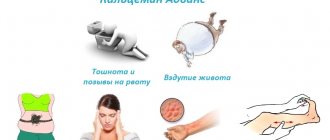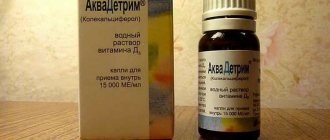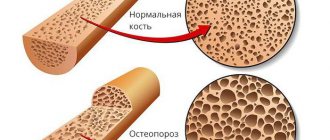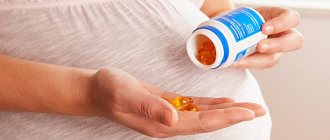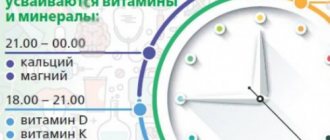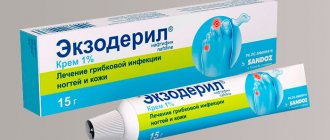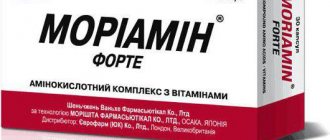Use of the drug Ergocalciferol
Orally, 10,000–100,000 IU per day with meals. The highest daily dose is 100,000 IU. For tuberculous lupus, the daily dose is 100,000 IU. The course of treatment can last up to 5–6 months. Children are prescribed either fractionally 500–1000 IU during the 1st year of life, or 50,000 IU once a week for 8 weeks, or an accelerated regimen of 300,000–400,000 IU for 10–12 days. For full-term children, up to 300,000 IU per course is prescribed for prevention from 3 weeks of age. premature babies, twins and bottle-fed children are prescribed up to 600,000 IU per course from the 2nd week of life. For the treatment of children with degree I rickets, 10,000–15,000 IU are prescribed for 30–40 days or for 10 days, for a course of treatment - 500,000–600,000 IU; with rickets of the second degree - 600,000–800,000 IU are required for the course of treatment; with rickets of the third degree - 800,000–1,000,000 IU are required for the course of treatment.
Instructions:
Clinical and pharmacological groups
17.001 (Vitamin preparation) 17.026 (Multivitamins with macro- and microelements and biogenic adaptogens) 17.016 (Multivitamins) 17.023 (Multivitamins with macro- and microelements) 29.033 (A drug that improves trophism and tissue regeneration, for external use) 21.031 (Fat-soluble vitamin s to add in solutions for parenteral nutrition) 19.005 (Antianemic drug. Complex of vitamins with microelements) 16.014 (Drug that regulates the metabolism of calcium and phosphorus)
pharmachologic effect
Vitamin D2, regulator of calcium and phosphorus metabolism. Increases the permeability of the intestinal epithelium for calcium and phosphorus, ensuring the necessary concentrations in the blood. Regulates the mineralization of bone tissue, as well as the process of mobilization of calcium from bone tissue. Promotes the reabsorption of phosphates in the renal tubules. Has cumulative properties.
Pharmacokinetics
Absorbed in the small intestine in the presence of bile by 60-90% (with hypovitaminosis - almost completely); in the small intestine they undergo partial absorption (enterohepatic circulation). With a decrease in the flow of bile into the intestines, the intensity and completeness of absorption decrease sharply. It circulates in the plasma and lymphatic system in the form of chylomicrons and lipoproteins. It is metabolized, turning into active metabolites: in the liver - into calcidol, in the kidneys - from calcidol into calcitriol. It accumulates in large quantities in the bones, in smaller quantities - in the liver, muscles, blood, small intestine, and is stored especially long in adipose tissue. Ergocalciferol and its metabolites are excreted in the bile, and a small amount is excreted in the kidneys.
Dosage
For oral or intramuscular administration, the daily dose varies from 10 mcg to 5 mg; The treatment regimen depends on the indications. For external use, the dose is determined individually.
Drug interactions
The effectiveness of ergocalciferol may be reduced during treatment with barbiturates or anticonvulsants. Can be used in combination with retinol.
The toxic effect is weakened by vitamin A, tocopherol, ascorbic acid, pantothenic acid, thiamine, riboflavin, pyridoxine.
Thiazide diuretics increase the risk of hypercalcemia.
With hypervitaminosis caused by ergocalciferol, the effect of cardiac glycosides may be enhanced due to the development of hypercalcemia (adjustment of the dose of cardiac glycoside is advisable).
Use during pregnancy and lactation
When prescribing ergocalciferol for therapeutic purposes to a nursing mother, breastfeeding is not recommended (to avoid the development of hypercalcemia in the child).
To prevent rickets in newborns and infants, it is possible to prescribe ergocalciferol during pregnancy and lactation (breastfeeding). The dosage regimen is set individually. Use with caution in pregnant women over 35 years of age.
Side effects
Possible: nausea, vomiting, headache, weakness, irritability, weight loss, increased urination, tissue calcification.
Rarely: heart rhythm disturbances.
Indications
For systemic use: prevention and treatment of rickets; disorders of calcium metabolism (including hypoparathyroidism, pseudohypoparathyroidism), accompanied by tetany, osteopathy, spasmophilia; osteoporosis, osteomalacia.
For external use: first and second degree burns (including sunburn), dermatitis accompanied by dry skin and peeling; baby diaper rash, diaper rash; prevention and treatment of cracked nipples (in the third trimester of pregnancy and lactation); to improve the healing of abrasions, scratches, and small wounds.
Contraindications
Hypercalcemia, active form of pulmonary tuberculosis, peptic ulcer of the stomach and duodenum, acute and chronic diseases of the liver and/or kidneys, organic heart damage.
special instructions
Use with caution, under medical supervision, in patients with heart disease and in elderly patients. With long-term use, especially in high doses, regular testing of calcium levels in the blood and urine should be carried out.
Preparations containing ERGOCALCIFEROL
• PHARMATON VITAL ◊ capsules: 30 or 100 pcs. • ERGOCALCIFEROL (VITAMIN D2) ◊ drops for oral administration (in oil) 0.0625%: fl. and drop bottle 10 ml or 15 ml • COMPLIVIT® “MOM” FOR PREGNANT AND NURSING WOMEN (COMPLIVIT “MAMA” FOR PREGNANT AND NURSING WOMEN) ◊ tab., cover. film-coated: 30 or 60 pcs. • FERROVIT FORTE ◊ tab., coated. casing: 30 or 60 pcs. • PREGNAVIT F tab. effervescent: 10 or 30 pcs. • ERGOCALCIFEROL ◊ 500 IU tablets: 10, 50 and 100 pcs. • HENDEVIT ◊ dragees: 50 pcs. • ERGOCALCIFEROL-RUSFAR oil solution for oral administration 0.125%: dropper bottle. 5 ml or 10 ml • FERROVIT ◊ tab., coated. casing: 30 or 60 pcs. • COMPLIVIT®-ACTIV (COMPLIVIT-ACTIV) ◊ tab., coated. film-coated: cans 30 or 60 pcs. • MEGADIN PRONATAL tablet, coated. shell: 30 pcs. • VITALIPID N ADULT (VITALIPID N ADULT) emulsion d/inf.: amp. 10 ml 10 pcs. • RADEVIT ◊ ointment for external use. approx. 5 mg+10 mg+50 mcg/100 g: tubes of 10 g, 20 g or 35 g • ERGOCALCIFEROL (VITAMIN D2) ◊ solution for oral administration, oily 625 mcg/1 ml: vial. 10 ml or 15 ml • VITALIPID N CHILDREN'S (VITALIPID N INFANT) emulsion d/inf.: amp. 10 ml 10 pcs.
Side effects
If large doses of the drug are used, hypervitaminosis D may develop, that is, excessive intake of vitamin D . In this case, the following symptoms may appear:
- nausea , loss of appetite;
- a state of general weakness ;
- headache;
- temperature increase;
- changes in laboratory parameters (appearance of protein in the urine, leukocytes , as well as an increase in the level of calcium in the blood, calcium deposition in the blood vessels, kidneys, lungs).
special instructions
If Ergocalciferol is prescribed to premature infants, it is advisable to simultaneously administer phosphates.
It is important to consider that sensitivity to vitamin D2 varies, so in some people even therapeutic doses of this medication can trigger the development of hypervitaminosis.
There may be different sensitivity to the drug in newborns. Children receiving high doses of the drug over a long period of time have an increased risk of growth retardation.
In order to prevent vitamin D2 deficiency, it is important to ensure a nutritious diet.
To date, the effectiveness of vitamin D2 in the treatment of psoriasis , rheumatoid arthritis, lupus vulgaris, and the prevention of nervousness and myopia is considered unproven.
It is not recommended to take Ergocalciferol for people with familial hypophosphatemia and hypoparathyroidism .
In older people, the need for this vitamin may increase, since its absorption decreases with age.
With prolonged use of large doses of the drug, it is important to conduct a study of the levels of calcium and phosphorus in the urine and blood.
Analogs
Level 4 ATX code matches:
Etalfa
Dihydrotachysterol
Oksidevit
Tevabon
Alpha D3-Teva
Aquadetrim
Vigantol
Analogs of this drug are the following drugs: Alpha D3-Teva , Aquadetrim , Alfadol-Sa , Videhol , Van-Alfa , Rocaltrol , Etalfa , Alfadol , etc.
What products contain
To reduce the risk of complications due to ergocalciferol deficiency, the following is added to the diet:
Products with a high content of vitamin D2.
- chicken eggs;
- fish oil synthesized from cod liver;
- different types of fish: salmon, perch, flounder, pike, herring, mackerel, pink salmon, chum salmon;
- mushrooms;
- butter, including ghee;
- goat milk;
- cheese;
- cottage cheese;
- cream;
- sour cream.
Interaction with other substances
Some drugs increase the toxicity of vitamin D2. These include thiazide diuretics, as well as products containing calcium. Ergocalciferol helps increase the effectiveness of cardiac glycosides. Under the influence of iodine it oxidizes.
Due to lipid-lowering drugs, ergocalciferol is absorbed more slowly.
Under the influence of ultraviolet radiation, synthetic vitamin D2 is converted into a toxic substance. The nutrient should not be taken simultaneously with beta-carotene, ascorbic acid, tocopherol, thiamine, pyridoxine.
Ergocalciferol concentrations are reduced by barbiturates. A number of drugs contribute to the disruption of the properties of this vitamin, such as glucocorticosteroids, drugs for the treatment of tuberculosis, antiepileptics and some hormonal medications.
Overdose
With hypervitaminosis (excess vitamin D2), symptoms associated with hypercalcemia . Early symptoms:
- constipation or diarrhea ;
- dry mouth;
- headache;
- thirst;
- nocturia , pollakiuria , polyuria ;
- anorexia;
- nausea and vomiting;
- metallic taste in the mouth;
- severe fatigue and asthenia;
- hypercalciuria, hypercalcemia.
Late symptoms:
- cloudy urine;
- bone pain;
- increased blood pressure ;
- photosensitivity of the eyes;
- drowsiness;
- conjunctival hyperemia;
- itchy skin;
- vomiting and nausea;
- pancreatitis;
- weight loss.
With chronic intoxication, arterial hypertension, calcification of soft tissues, lungs, kidneys, blood vessels, impaired child growth, cardiovascular and renal failure can develop.
At the first symptoms of hypervitaminosis D2, you should immediately stop the medication and prescribe the patient to take vitamins A , C and B.
pharmachologic effect
The drug provides regulation of calcium and phosphorus metabolism, absorption of these elements in the intestines, as well as their deposition in bone tissue. The product provides protection against rickets resulting from vitamin D
Active metabolites of fat-soluble vitamin D2 quickly pass through cell membranes and bind to special receptors in cells. As a result, the synthesis of calcium-binding proteins is activated, and the absorption of calcium and phosphorus in the intestine improves.
How to get a connection
Vitamin D2 can be obtained from food. This nutrient is not produced independently, but is needed by the body to ensure vitality, since it participates in various biochemical processes. For comparison: vitamin D3 is found in animal foods, but can also be formed in the structure of the skin under the influence of solar radiation. These nutrients should not be confused.
To get your daily dose of the vitamin, it is recommended to eat enough foods containing it. However, this is not always possible. In this case, the option of taking special medications that include ergocalciferol is considered. This substance is synthesized artificially.
Stages of this process:
Scheme of vitamin D2 synthesis.
- separation of photoresin from ergosterol;
- obtaining vitamin D2 3,5-dinitrobenzoate;
- release of vitamin D2 in free form.
An alcohol solution of ergosterol is used as a raw material for the synthesis of ergocalciferol. It is irradiated, then the ether is distilled off. At the same time, concentration increases.
Under the influence of low temperature, unreacted ergosterol crystallizes. The resulting crystals are separated. The ergosterol-free solution is further manipulated to remove the remaining ester.
The resin is being cleaned. For this purpose, alcohol and dry sulfuric ether are used. At the next stage, 50% of the solvent is distilled off, the liquid again enters the crystallizer to separate additional amounts of sterols.
The product 3,5-dinitrobenzoate vitamin D2 is obtained as a result of the interaction of photo resin and 3,5-dinitrobenzoyl chloride, pyridine acts as the base component. The last of the substances takes an active part in obtaining the free form of vitamin D2.
Who needs an increased supply of D2
It is recommended to take ergocalciferol for people of different categories:
- those who lead a sedentary lifestyle;
- women during pregnancy and lactation (in this case, to compensate for D2 deficiency, it is necessary to change the diet - the intake of synthetic nutrients may be limited for a number of reasons);
- patients with impaired renal function, organic diseases of the intestines, gall bladder, liver;
- everyone who develops dental disease experiences a general deterioration in their condition;
- children with rickets;
- elderly people who are concerned about general muscle weakness;
- overweight people.

